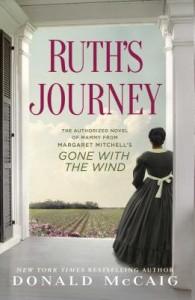Title: Ruth’s Journey: The Authorized Novel of Mammy from Margaret Mitchell’s Gone with the Wind
Author: Donald McCaig
ISBN: 9781451643534
No. of Pages: 384
Genre: Historical Fiction
Origins: Atria Books
Release Date: 16 October 2014
Bottom Line: Not as good as I would have liked
 Synopsis:
Synopsis:
“On the Caribbean island of Saint Domingue, an island consumed by the flames of revolution, a senseless attack leaves only one survivor — an infant girl. She falls into the hands of two French émigrés, Henri and Solange Fournier, who take the beautiful child they call Ruth to the bustling American city of Savannah.
What follows is the sweeping tale of Ruth’s life as shaped by her strong-willed mistress and other larger-than-life personalities she encounters in the South: Jehu Glen, a free black man with whom Ruth falls madly in love; the shabbily genteel family that first hires Ruth as Mammy; Solange’s daughter Ellen and the rough Irishman, Gerald O’Hara, whom Ellen chooses to marry; the Butler family of Charleston and their shocking connection to Mammy Ruth; and finally Scarlett O’Hara — the irrepressible Southern belle Mammy raises from birth. As we witness the difficult coming of age felt by three generations of women, gifted storyteller Donald McCaig reveals a portrait of Mammy that is both nuanced and poignant, at once a proud woman and a captive, and a strict disciplinarian who has never experienced freedom herself. But despite the cruelties of a world that has decreed her a slave, Mammy endures, a rock in the river of time. She loves with a ferocity that would astonish those around her if they knew it. And she holds tight even to those who have been lost in the ravages of her days.
Set against the backdrop of the South from the 1820s until the dawn of the Civil War, here is a remarkable story of fortitude, heartbreak, and indomitable will — and a tale that will forever illuminate your reading of Margaret Mitchell’s unforgettable classic, Gone with the Wind.”
Thoughts: Ruth’s Journey is nothing more than fodder for fans of Margaret Mitchell’s classic. If anything, Ruth’s actual journey shows just how small the South actually was given with whom Ruth interacts, when, and why. All of the key figures of Ms. Mitchell’s novel are here, and fans will have a blast connecting the dots between them and seeing certain famous scenes through someone else’s eyes. Without this singular interest however, readers unfamiliar with the O’Hara and the Robillard families will find Ruth’s Journey rather dull.
For one thing, while Ruth is in almost every scene, she is most certainly not the main character during the first half of the novel. The first half is all Solange Fornier Robillard. In it, readers discover that Scarlett comes by her obstinance and tendency to flout society rules not just from Gerald’s side of the family. The similarities between Solange and Scarlett are undeniable and makes a lot of sense when trying to build a bridge between two novels. Yet, the whole thing is just too expected and therein lies the rub. In trying to create a novel that connects to a much-beloved classic, one expects certain connections and discoveries. There is nothing terribly surprising about anything that happens in the novel, and all of it feels repetitive. Solange is a perfect stand-in for Scarlett, even down to the number of children she has as well as the number of husbands.
Then there is Ruth herself. This is not the Mammy from the novel or the movie. It is supposed to be how she came to be so feisty and outspoken, but one never sees Ruth adopt that persona. Even before she moves to Tara with the newlyweds, this version of Mammy lacks that spirited bite with which she attacks her duties. Throughout most of the novel, Ruth is a follower; she is meek, mild, and bound by a slave’s code of silence towards her white owners. At her lowest point, she remains quiet and implacable. The Mammy from the original book is anything but quiet and certainly not implacable.
There is more to Ruth’s life other than her time with the O’Hara’s, especially with Scarlett and her sisters, but that ends up being the part of the story readers will remember the most. In many ways, this is fitting because Mammy only became famous because of Scarlett O’Hara. One wants to see young Katie Scarlett and how she grew into the formidable woman she became. However, that portion of her life is such a small portion, that for readers not to remember or care about the path of her life prior to Tara is a disservice of the author.
Mr. McCaig tries to maintain a fan’s interest by throwing in well-known names and faces – ones that play a large role in the original story. This only works for a time before it begins to test a reader’s patience. The coincidental meetings between Ruth and the Hamiltons, the Butlers, the O’Haras, and pretty much everyone else who factors into Scarlett’s adult life only works to a certain extent before they become too convenient and nothing more than a plot device to keep a reader’s interest.
The final lasting impression of Ruth’s Journey is not one of marvel at everything she endures. Rather, it is one in which readers will wonder at everyone’s ages in Gone With the Wind. Ruth meets all of the supporting cast years before Scarlett’s birth, which drives home her incredible youth and the acceptability of Southern women marrying men twice their age. It is definitely not the impression one imagines Mr. McCaig was hoping to make when he started the novel, but it is there nonetheless.
In the end, it becomes too difficult to reconcile Ms. Mitchell’s Mammy with Mr. Mccaig’s version. They do not have the same voice or the same spark. While one knows that Ms. Mitchell’s Mammy has eons of experience under her kerchief, one gets the uneasy sense that what happens in Ruth’s Journey is just not it. While fans, like this reader, will continue to flock to anything remotely related to Ms. Mitchell’s masterpiece, it is best to start Ruth’s Journey with the understanding that it is a paltry substitute for the original. Only then can one sit back, enjoy the story, and get a tiny thrill every time a familiar name crosses the page.
